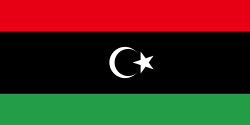Panarabiske farver

De panarabiske farver er farverne rød, sort, grøn og hvid og repræsenterer de arabiske lande[1]. Farverne er taget fra forskellige store imperier og dynastier i arabisk historie[2]. De blev første gang kombineret i flaget for den Arabiske Revolte i 1916. I dag indgår de i flagene for de Forenede Arabiske Emirater, Jordan, Kuwait, Palæstina, Sahariske Arabiske Demokratiske Republik og Somaliland. De arabiske befrielsesfarver, en undergruppe hvor grøn er af mindre betydning, bruges i Egyptens, Iraks, Sudans, Syriens, Yemens og Libyens flag[3] .
Nuværende flag med de panarabiske farver
De følgende flag kombinerer tre eller fire af farverne rød, sort, hvid og grøn for at symbolisere den arabiske tilhørighed[4].
Somaliland
Tidligere flag med de panarabiske farver
Libyen (1969–1972) Irak (1921–1959) Arabiske føderation (1958) Irak (1959–1963) Irak (1991–2004) - Syrien (1920-03-08 til 1920-07-24)
Syrien (1932–1958 og 1961–1963) Forenede Arabiske Republik (1958–1961) Nordyemen (1962–1990) Sydyemen (1967–1990) - Arabiske Islamiske Republik (1974)
- Hejaz (1917–1920)
- Hejaz (1920–1926)
- Hejaz (1926–1932)
Tidligere arabiske flag
Rashidun-kalifatet
(632–661)Umayyade-kalifatet
(661–750)Abbaside-kalifatet
(750–1258)Fatimide-kalifatet
(909–1171)Ayyubide-dynastiet
(1171–1341)Mameluk-sultanatet
(1250–1517)
Eksterne henvisninger
- ^ WorldAtlas.com om de panarabiske flags farvebetydning, hentet d. 31. januar 2020
- ^ ArabicWithoutWalls.com Arkiveret 27. maj 2016 hos Wayback Machine om de panarabiske flags historie og betydning, hentet d. 31. januar 2020
- ^ Flags Of The World Website om de panarabiske flag, hentet d. 31. januar 2020
- ^ Washington Posts artikel om de panarabiske flag, hentet d. 31. januar 2020
| Spire Denne artikel om flag eller vexillologi er en spire som bør udbygges. Du er velkommen til at hjælpe Wikipedia ved at udvide den. |
Medier brugt på denne side
Det er let at give dette billede en kant
Flag of the Kingdom of Hejaz from 1920 to 1926 and flag of Hejaz as part of the Kingdom of Hejaz and Nejd from 1926 to 1932. This flag was also used by the Sharifian Caliphate from 1924-1925, before Hejaz merged with Nejd to form a union (1338 to 1350 AH).
Flag of the Shortlived Arab Federation of Iraq and Jordan (1958)
Flag during the short lived Kingdom of Syria from March 8th to July 24th 1920
Flag of Hejaz from 1917 to 1920 (1335-1338 A.H.), commonly known as the "Arab revolt flag".
Former Iraqi flag, used from 1991 to 2004.
Mameluke Flag over Cairo according to the Catalan Atlas c. 1375 created by James Dahl. The golden banner is supposedly identical to the Ayyubid banner.
Rectangular green flag. This flag should not be used to represent the Fatimid Caliphate. Note that the concept of rectangular national flags did not exist during Fatimid times, and that the dynastic color of the Fatimids was white, not green (just as black was the dynastic color of the Abbasids, etc.).
A flag used during the Umayyad dynasty (660–750)
Forfatter/Opretter: historicair 16:39, 1 May 2007 (UTC), Licens: CC BY-SA 3.0
Drapeau de la République arabe islamique (Union tuniso-libyenne) d'après la description figurant dans le protocole de l'union rapporté dans le livre Les trois décennies Bourguiba de Tahar Belkhodja
Forfatter/Opretter:
- Inkwina
- Urutseg
Иконка для статей-заготовок о флагах.
Det er let at give dette billede en kant
The Egyptian flag (1972-1984). Also the flag of Libya (1972-1977) and Syria (1972-1980), when the three countries formed the nominal “Federation of Arab Republics”. (For a map of the federation, see Image:Esl.PNG.)
The Arab text in the scroll held by the “Golden Hawk of Qureish” reads Arabic اتحاد الجمهوريات العربية, ittiħād al-jumhūriyyāt al-`arabiyya, i.e. the Federation (literally “Union”) of Arab Republics — in a quasi-Kufic script (in its original form, with a very ornamental letter dal د).
Flag of the Libyan Arab Republic (1969-1972)
Flag of Syria. Originally flag of the Syria Revolution (from 2011), de facto flag of Syria beginning December 2024, official beginning March 2025.
Flag of the Iraqi Republic, used officially in different forms from 1963-2008.
This Black flag has been the flag of various Afghan rulers: Flag of Zengid dynasty and Flag of Afghanistan (pre-1901) and the flag of the Black Guards. This flag has also been the flag of the Sadozai Sudhan rulers of Sidhnuti This can be used to represent the Abbasid Caliphate, since while the concept of rectangular national flags did not exist during Abbasid times, black was the dynastic color of the Abbasids and the "black banner" of the Abbasids is famous in Islamic history. It was also used by many Islamic dynasties in different regions of the world till the late 19th century. It is also used by anarchist groups and pirates.
Also has been the flag of Makhnovshchina.The Syrian Independence flag, the flag of Syria from 1930-58, 1961-63. Today, it is used as a 2:1 variant.
Flag of Ayyubid. The Ayyubid dynasty is often represented by the colour yellow.
"The Ayyubids and Mamluks, who succeeded the Fatimids in Egypt and Syria, retained the association of yellow with the ruler." Jane Hathaway, A Tale of Two Factions: Myth, Memory, and Identity in Ottoman Egypt and Yemen, p. 97.



























































